Best Exercises for Backpacking
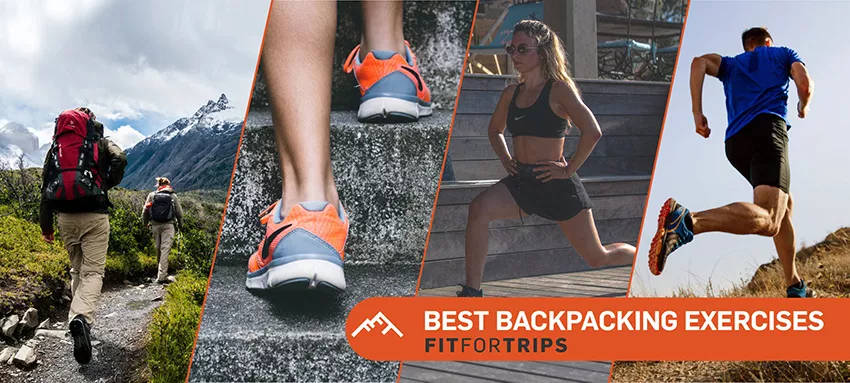
I used these tried and true exercises for backpacking to train for the Rocky Mountain Wind River Traverse trip with NOLS detailed below. *You can use these same exercises for your backpacking trip.
1 – Hiking with light to moderate pack weight
2 – Carrying very heavy pack weight on flat or convenient neighborhood walks
3 – Stair walking
4 – Ascending hill repeats
5 – Lower body exercises
 Socially distanced backpacking in the Sheep Desert in Bridger Teton National Forest.
Socially distanced backpacking in the Sheep Desert in Bridger Teton National Forest.
Backpacking Wyoming Wind River Traverse trip details
NOLS Rocky Mountain – Lander, WY August 1-9, 2020
- Approx. 60 miles, backpacking across Wyoming’s Wind River Mountains
- Nine days, eight nights in the field
- On and off trail hiking at or above tree line at 8,000-12,000 feet
- Average pack weight: 40-50 pounds
- Distance: 8-10 miles per day
- Daily elevation gain expectations were 2000-2500 ft
*The trip turned out to be less rigorous than expected.
As for my training, I started from scratch (no backpacking experience and little hiking stamina). While it was early in the pandemic and the trails were closed, my workouts included local walks, stair walks in an open parking garage, and a Fit For Trips leg workout. Once the trails opened, I hiked 3-4x each week. When performing leg workouts and ascending hill repeats, I would do 1x per week (on a local steep street). The last two weeks of training included an overnight trip on the Long Trail and summiting local mountains with heavy pack weight.
The backpacking exercises I performed were more aggressive than what turned out to be necessary, but I felt amazing.
We hiked mostly at around 9,000-10,000 ft elevation across the Wind River Range from the Worthen Reservoir trail head along the Popo Agie river, through Lizard Head Meadows, over Texas Pass on day five, through the Sheep Desert to the Scab Creek trailhead.
I trained 194 miles and 34,828 ft elevation gain total. My average training pack weight was 43 lb.
According to the Gaia trip data readings, I hiked a total 43.77 miles with total elevation gain of 6139 ft. My trip pack weight was about 48 lb.
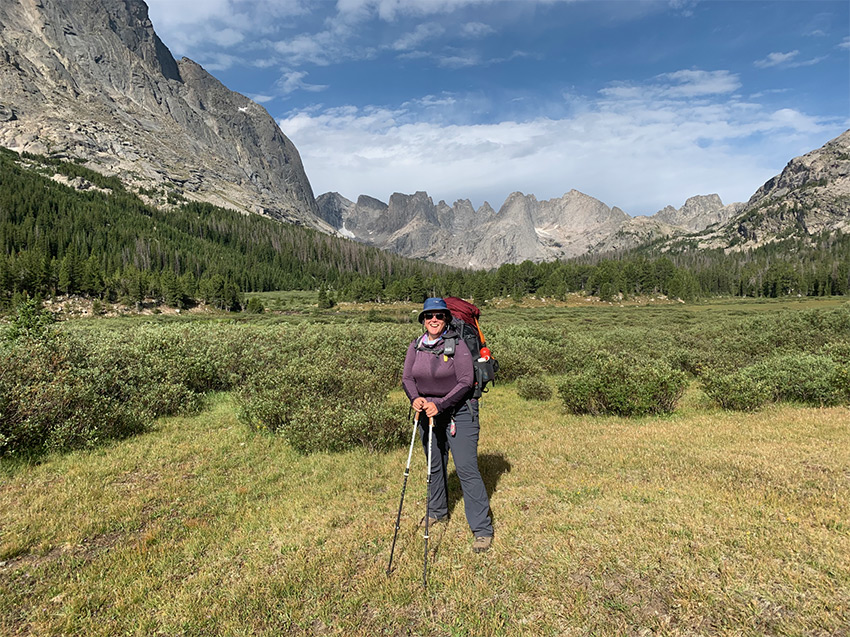 Lizard Head Meadows in front of Cirque of the Towers in Shoshone National Forest.
Lizard Head Meadows in front of Cirque of the Towers in Shoshone National Forest.
Backpacking Trip and Exercise Total Summary

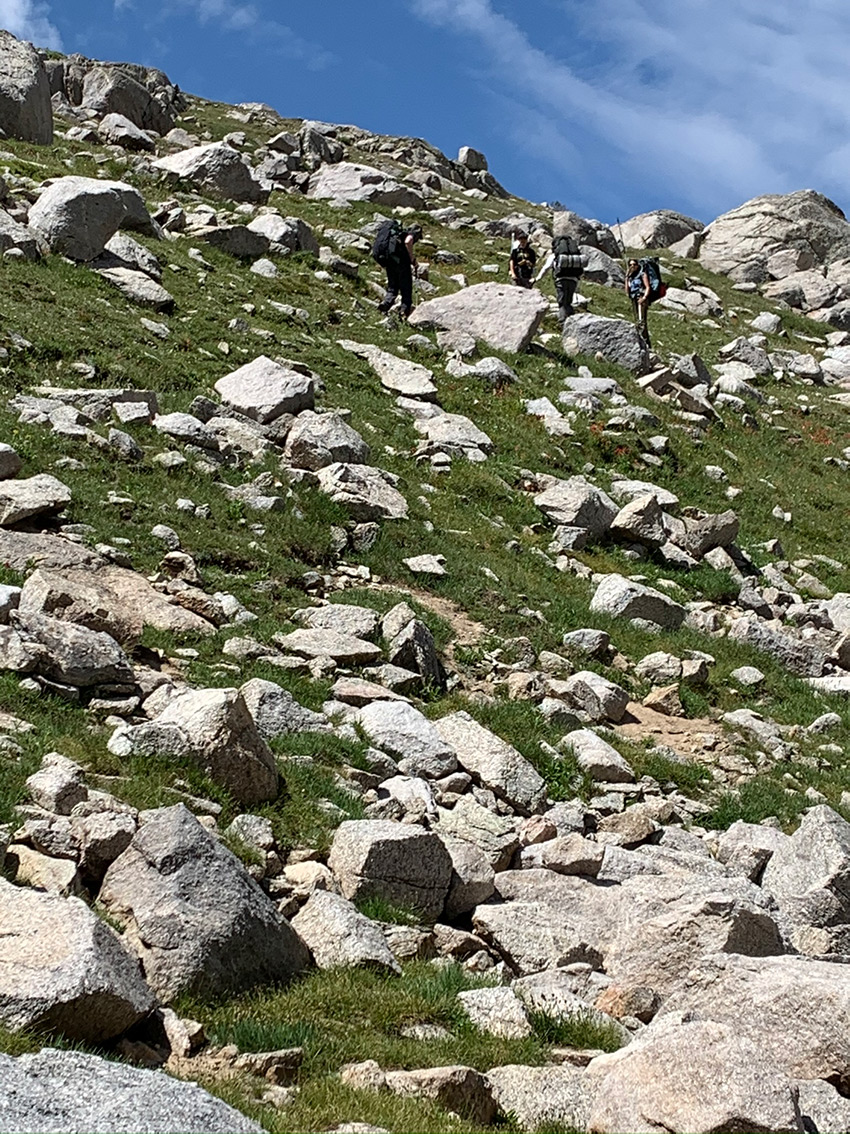 Climbing toward Texas Pass.
Climbing toward Texas Pass.
Backpacking Exercise Codes Explained
H / Hiking – Try to find a dirt trail that has some elevation changes.
W / Walking – This can be a hike, but you can also just walk in your neighborhood if it’s more convenient. Flat or neighborhood terrain is an opportunity to overcompensate with pack weight when walking short distances.
SW / Stair Walking – Find stairs at a park, high school stadium, or at home and use this stair elevation gain calculator to create your workout based on elevation gain you want to achieve.
AR1 / Ascending Repeats – Requires access to a hill. The 1, 2, and 3 in the code means 1 minute, 2 minutes, and 3 minutes, respectively. For AR1, start at the top of a hill; set a 1 minute timer and walk down the hill; once the timer is up, turn around and head back to the hilltop at a brisk pace.
Leg Training – Perform the hiking leg workouts detailed in this article.
Details of all Exercises for Backpacking

Gear I Used for my Backpacking Exercises and Trip
I performed most of my backpacking exercises with my Deuter 60-liter pack. I made my own pack weights by filling a gallon-size Ziplock bag with sand, which weighed 10 lb. I then duct-taped the whole thing really well so it wouldn’t leak. I also used water bladders. Closer to my trip (in weeks 10-13), I swapped out the weights for actual gear. I weighed my pack with this luggage scale. I used this counter to track stair climbs.
As for water, which is so essential during training, I carried a 2-liter water bladder. I don’t recommend this one for the actual trip. Once it’s empty, it’s hard to refill without unloading your whole pack. We also had frequent access to water in Wyoming. Additionally, I used a Nalgene with hydration tablets in it daily. At higher elevation I found that I drank a lot of water.
I did not have any injuries or medical issues during training or the trip. I was concerned about developing plantar fasciitis but was careful to stretch my calves and hamstrings after hikes.I wore Lowa Renegade boots for all my training, achieving both an adequate break-in of the boots, as well as preventing foot issues.
 Climbing toward Texas Pass with my backpacking buddies.
Climbing toward Texas Pass with my backpacking buddies.
Caroline’s experience working with Fit For Trips and using our suggested exercises for backpacking
1. How would you rate your level of satisfaction with the exercise program and coaching?
Highly satisfied = this was an incredible value for the results I achieved. The coaching was spot on, a perfect blend of online programming and access to a coach for live conversations and review.
2. What was the most positive part of your Fit For Trips experience?
The personalized program and online portal were perfect and helped me stick to the program and be consistent. I also appreciated the access to my coach so I could have a dialog and address questions / concerns as I moved forward. This also resulted in me being more than ready for the backpacking expedition I was training for. I was well prepared and able to enjoy the trip, as well as other excursions.
 Camping at Papoose Lake in Popo Agie Wilderness.
Camping at Papoose Lake in Popo Agie Wilderness.
3. Were you skeptical about using Fit for Trips? Now that your adventure trip is over, do you think the Fitness Program worked for you?
I was not skeptical at all because I was referred by someone who used Fit For Trips for a big adventure. I absolutely do think the program worked for me. I would not do anything differently in hindsight. I was so well prepared for my trip. My trip leaders were super impressed as well. Fit For Trips clearly used the best exercises for my backpacking trip.
4. Please give an example of how the Fit For Trips backpacking exercise program enhanced your experience.
The diversity of backpacking exercises (trail, ascents, stair climbs, leg workouts) helped me stick to the program. I wasn’t bored and was able to collaborate with my coach to adjust the program as needed (schedule, physical needs, etc). As a result of my preparation, I was able to completely enjoy my trip. I had no issues with adjustments to elevation, terrain, or distance. The varied aspects of the program (workout type, pack weight, time, distance) definitely prepared me perfectly for the varied aspect of my trip adventure. I was able to comfortably hike for 6-8 hours a day with a 50 lb pack, at elevations over 8500’. The leg workouts also made river crossings, boulder fields, and steep descents over scree easily traversable.
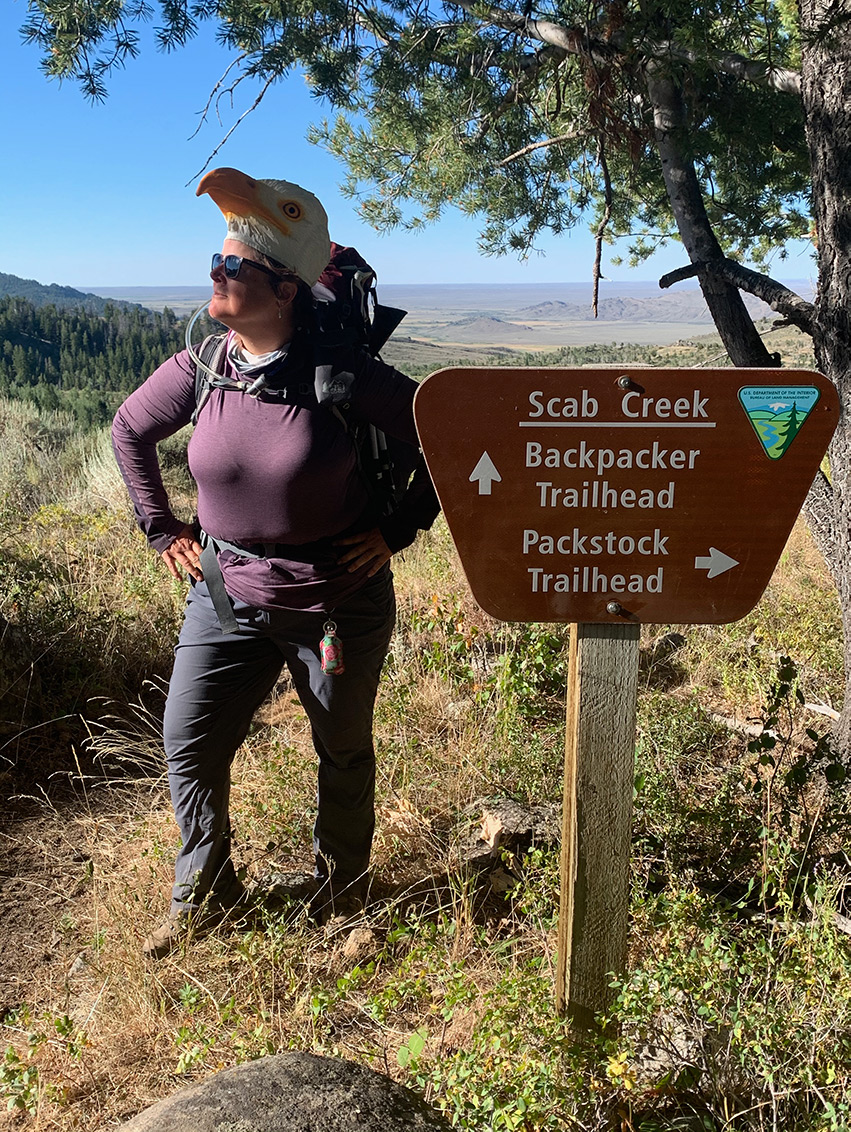 End of hike at Scab Creek trailhead.
End of hike at Scab Creek trailhead.
5. Any specific examples about how your enhanced level of fitness helped you on your trip?
Before working with Marcus (Fit For Trips head trainer), I was a middle-aged “desk jockey” whose only workouts were bootcamps a few days a week and the occasional day hike at sea level. After working with him, I was able to do the Wind River Range (WY) traverse (~45 miles over 8 days with 2 zero days). The highlight was a climb over Texas Pass (11,000 ft) with a ~50 lb pack on my back. The western side of the pass was a very steep descent over talus and scree. Because of my conditioning, I had no issue doing this with a heavy pack. My knees were strong and solid! I had no issues hiking 7-10 miles a day with elevation gain of 2000’+. Others in my group were impressed with my preparation. I think my instructors honestly thought that at some point they’d need to reduce my pack weight or slow down. I kept up with the entire group, which included very fit people in their 20s; my hiking speed and ability were a match.
 Looking back at Texas Pass from Bridger Teton National Forest.
Looking back at Texas Pass from Bridger Teton National Forest.
6. Please add anything else you’d like us to know.
Marcus took the time to get to know me as a person, as well as my style. I think it was especially important that he understood my goals. It wasn’t just to be able to hike the trip. I wanted to feel like I was just as strong as the rest of the group and wasn’t perceived as the one slowing the group down. The training was definitely hard work and of course there were days when I had to dig deep to push forward. Marcus was very accessible and understanding when I would tell him how I was feeling both physically and emotionally. He was also very patient in teaching me about the conditioning plan and how my body was responding. The timing was perfect; he was very attuned to when the trip would start and what I needed to be doing right up until that point so that I didn’t over train. I was never injured during my training and therefore was never injured during my trip either. I will absolutely work with Marcus again for any adventure trips I do.
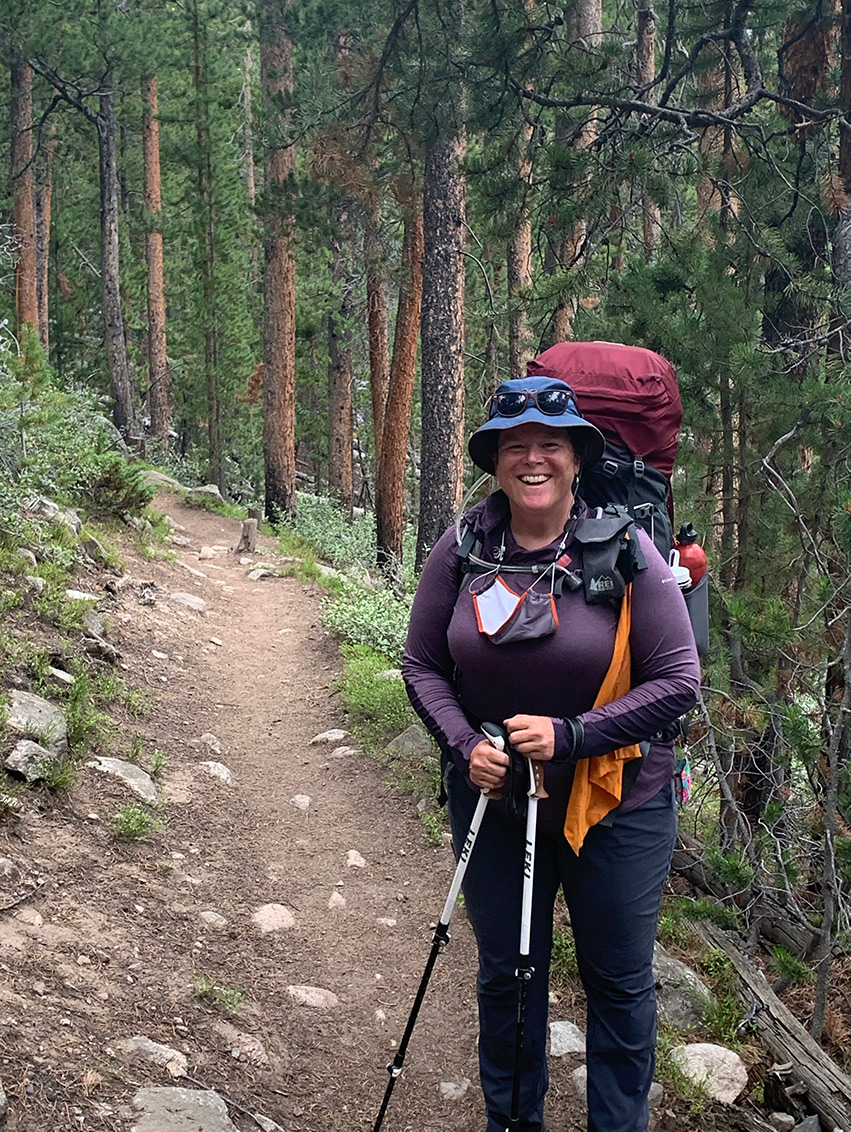 Caroline at Worthen Reservoir trailhead.
Caroline at Worthen Reservoir trailhead.
